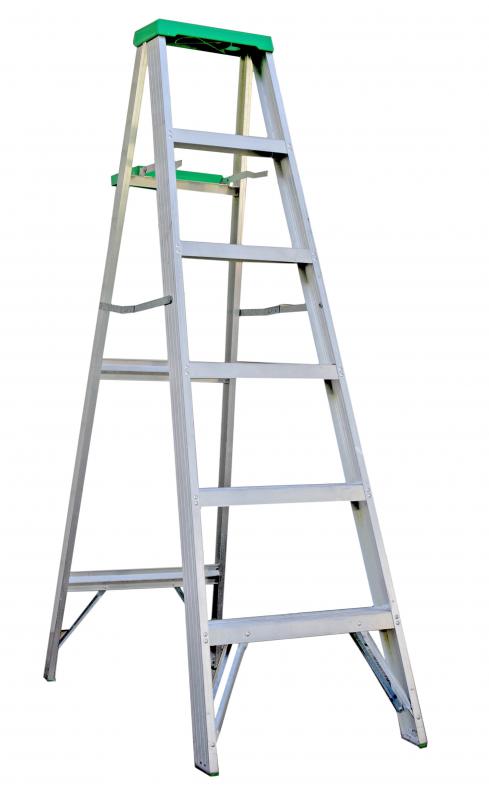At HomeQuestionsAnswered, we're committed to delivering accurate, trustworthy information. Our expert-authored content is rigorously fact-checked and sourced from credible authorities. Discover how we uphold the highest standards in providing you with reliable knowledge.
Can I Install a Ceiling Fan?
There was a time when it was nearly impossible to install a ceiling fan solo. One person was required to hold the fan while another connected the wiring from the ceiling. Now fans are made to support themselves while these connections are made, making it easy for just about anyone to install a ceiling fan, assuming the ceiling is pre-wired.
Ceilings that have been pre-wired will be fit with a metal support (called a junction box) at the fixture site. If the support in the ceiling is made from plastic, it was only designed to hold a light and will need to be replaced with a metal box to support the significant weight of a ceiling fan. Metal junction boxes are rated to hold 35 pounds (15.87 kg). If the fan weighs more, its support bracket will have to be attached to a ceiling joist or beam.

In the center of the junction box is a hole where the building’s internal wires exit. Before touching any wiring in the ceiling be sure to turn off the circuit breaker that sends power to that location. Working with live wires can lead to electrical shock and serious injury.
There should be four wires if the ceiling has been pre-wired for a ceiling fan. A green wire for ground, black for power to the fan, red or blue for power to the light, and a common white wire. When the wires are unattached to a fixture, the ends should be sealed with electrical tape or capped with plastic terminators to avoid making contact with one another.

Assuming the ceiling fan is new, it will need assembly. Open the box, unwrap and lay out the parts in an organized fashion to make the job easier. Before you install a ceiling fan, read the instructions all the way through. Familiarize yourself with the parts. This will help avoid incorrect assembly that can require backtracking and extra time.
The initial step to install a ceiling fan usually requires attaching a support bracket (that comes with the fan) to the existing ceiling bracket. The support bracket will make it possible to hang the fan while connections are made. Some support brackets provide an open insert for the downrod and motor assembly. Others use a heavy wire hanger that extends from the top of the downrod and attaches to a metal bracket built into the ceiling plate.

With the power shut off and the partially-assembled ceiling fan hanging from the support bracket, wiring can now be connected. Ideally the wires from the ceiling will be color-coded to match the ceiling fan wires. If the ceiling wires are differently colored, ask an electrician if you have any doubts as to how to attach it properly.
Once the wires are connected the fan can be hoisted into place and the upper canopy lifted and screwed into the rim of the ceiling support base. From here blades or paddles are attached with screws. A light kit is often included, but sometimes sold separately. If you don’t require a light, the fan’s wire housing is capped with a decorative under pan.
If you prefer to add a light kit when you install a ceiling fan, they are often pre-assembled and only require connecting a wire harness and housing. Many use candelabra-style bulbs with small bases, so be sure to get the correct type and wattage. A glass bowl fits beneath, commonly with a decorative knob that screws on the light rod stem. When the job is complete turn on the power and be sure the pull-chains are in the “on” position to test the fan and light.
You’ll only need a ladder and a few basic tools to install a ceiling fan, and it should take about an hour and a half. Fans also come with a balancing kit, if required. This keeps the fan from wobbling at higher speeds.
If your ceiling is not pre-wired for a ceiling fan, an electrician can run the necessary wiring and install a metal junction box at the site. This might be more expensive than the fan itself, but you’ll be able to enjoy the ceiling fan for years to come. You might also recoup the investment on lower heating and air conditioning costs over time.
AS FEATURED ON:
AS FEATURED ON:













Discussion Comments
My biggest worry with installing the ceiling fan was getting the wiring hooked up correctly. We have an old house and the wires in the ceiling were not marked with the colored caps. I thought I knew how they all hooked up, but I decided to have an electrician do the job to be certain-- better safe than sorry.
My biggest worry with installing the ceiling fan was getting the wiring hooked up correctly. We have an old house and the wires in the ceiling were not marked with the colored caps. I thought I knew how they all hooked up, but I decided to have an electrician do the job to be certain-- better safe than sorry.
Deciphering them might take a while, but all the instructions you need to figure out how to install a new ceiling fan will come in the box with the fan. I don't like reading instructions, so I skimmed the instructions instead of reading them closely. This meant I had to go back and reread some steps, but I eventually got the fan together and installed.
Having a professional put up the fan would have been quicker, but since we were in no rush I did it myself and saved some money in the process.
Post your comments